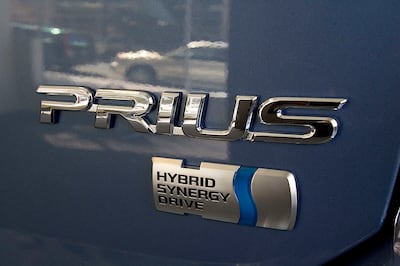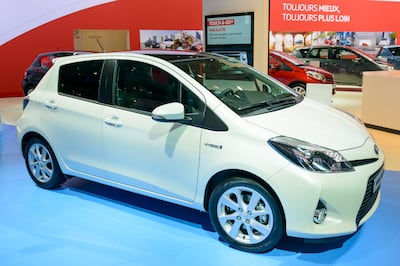After spending the past decade as the car industry’s loudest champions of hybrid vehicles, Toyota executives could be forgiven for feeling some measure of vindication.
The Japanese carmaker’s dogged determination to pour billions into hybrid vehicles that combine batteries with the traditional internal combustion engine drew criticism from investors and environmentalists alike.
Consumers would balk at buying more expensive fully electric cars, Toyota repeatedly warned. Now, as a combination of stubbornly high prices and concern over inadequate charging infrastructure chills enthusiasm for battery electric vehicles (BEVs) in markets from Europe to the US, what was once regarded as heresy from Toyota is being reassessed.
Adam Jonas, an analyst at Morgan Stanley who confidently predicted that aggressive government regulation and a consumer preference for fully electric models would quickly extinguish the hybrid market, this month admitted: “I owe Toyota an apology.”
While demand for BEVs has risen over the past three years, according to data compiled by Jato Dynamics, their share of the new car market shrank in the UK and sales growth slowed in the US and Europe.
The shift in the market has already strengthened Toyota’s bottom line: sales of hybrids at the world’s largest carmaker climbed by almost 1mn to 3.4mn last year, helping the company raise its forecast for operating profit to a record ¥4.9tn (€30 billion) for the year to March.
Hybrids come in several varieties. Plug-in hybrids, or PHEVs, can run for dozens of miles on electric power alone and be charged at home, though their large battery means they are generally expensive. Full hybrids combine a smaller battery and a traditional engine that run together, making them cheaper both to buy and run.
The majority of the industry still believes that developing profitable BEVs is the most important long-term goal for carmakers, but the mini-renaissance of hybrids is forcing some to change their plans. In a US hybrid market mainly dominated by Toyota, Honda and the South Korean duo of Kia and Hyundai, domestic manufacturers are racing to catch up.

Last month General Motors, which had largely phased out plug-in hybrids from its range, said it would reintroduce the technology as it acknowledged that customers were taking longer than expected to embrace fully electric models. Ford, which bet on hybrids as an interim technology, predicts its sales of such models will surge 40 per cent this year, double last year’s pace. It sold more than 52,000 Maverick pickup trucks in 2023, making it the fifth best-selling hybrid in the US after models from Toyota and Honda.
“Our data shows that EVs are a clear destination for many customers . . . [but] it’s going to take more time than we expected 18 months ago,” Ford chief executive Jim Farley told investors this month. “Hybrids will play an increasingly important role in our industry’s transition and will be here for the long run.”
It amounts to a notable revision to the previously gloomy outlook for hybrids, which according to Jessica Caldwell, head of insights at Edmunds, an online resource for car shoppers, have been overlooked as a bridge strategy because they “didn’t feel sexy and cool”.
Their combination of battery technology and traditional engines is central to their appeal for Toyota. Hybrids allow carmakers to cut emissions while drawing out the final years of the combustion engine that has been the industry’s cash cow for the past century.
Carmakers who are reaping profits now from their existing hybrid models had better use this time and money wisely as BEVs are coming, sooner or later.
Full hybrids are highly profitable, often with double-digit margins that surpass those for traditional engine-only or plug-in hybrid cars, and certainly BEVs, which are often loss-making.
Carlos Tavares, chief executive of Stellantis, said that by increasing BEV sales to “green addicts” as well as shifting more hybrids, you “can make a very good impact on the planet”.
Investors have already rewarded Toyota, sending its shares up more than 80 per cent over the past 12 months. Shares in Tesla, whose focus on a small number of BEV models is a sharp contrast to Toyota’s strategy of selling cars across multiple price points and technologies, have fallen over 5 per cent in the same period.
Carl Vine, a portfolio manager at M & and a Toyota shareholder, thinks the company has “gotten an unfair rap in recent years”.
“The powerful pro-electrification lobby and some Toyota critics have insinuated they are backsliding on electrification,” he said. “Toyota from the very beginning has said, ‘this is all quite complicated – we need to take our time and pursue multiple pathways’.”

Germany in recession: What does it mean for Ireland and the EU?
Toyota’s chair Akio Toyoda last month predicted that demand for BEVs would hit a ceiling at 30 per cent of the global market, opening the way for more hybrid sales.
The company has said it will be selling 5 million hybrids annually by about 2025. By contrast, Toyota has targeted just 3.5 million BEV sales annually from 2030. It only shifted 104,000 last year, while selling 125,000 plug-in hybrids.
Jaguar Land Rover, an industry laggard, is among the carmakers benefiting from the pickup in hybrid demand. With its first flagship Range Rover BEV not due for launch until the end of the year, the company says hybrid sales will help it comply with UK emissions rules even after it delayed the release of some BEV models.
Yet the brightening outlook for hybrids only changes, rather than ends, the challenges facing the industry as it grapples with climate change and the varied demands governments around the world are making on carmakers to help fight it.
“Carmakers who are reaping profits now from their existing hybrid models had better use this time and money wisely as BEVs are coming, sooner or later,” said James Hong, autos analyst at Macquarie.
Despite the cooling in the pace of BEV sales last year, they have already overtaken hybrids in most big markets, apart from Japan, which remains a stronghold for the technology.
Luca de Meo, chief executive of Renault, said that even amid the slowdown in demand for BEVs, they would have to dominate the European market if the industry was to meet the EU’s emission targets.
“You don’t need to have a Nobel Prize in maths to understand EVs need to be a big part of it,” he said.

And with China pursuing aggressive targets for fully electric vehicles, it is the US – a country with longer commuting distances and a more entrenched love of petrol-guzzling engines – that looks set to become the battleground that will determine hybrids’ longevity.
Doug Eroh, president of the Longo Toyota dealership in suburban Los Angeles, said hybrids’ share of its sales more than doubled from 2019 to 42 per cent last year and he expected them to total “well over 50 per cent of our business this year”.
But predicting the long-term trajectory for hybrids in the US is fraught, say analysts, especially with a presidential election in November that could reshape the market.
I think what you’re really seeing is that the Big Three automakers are constraining production [of BEVs] to protect margin.
Senior advisers and campaign officials have said that a second Donald Trump administration would look to roll back President Joe Biden’s landmark Inflation Reduction Act, which included $369 billion (€247 bilion) in tax breaks and subsidies to speed up America’s transition to renewable energy.
“If we have a change in administration, you will probably see the US automakers start sounding like Toyota saying 30 per cent electrification forever,” said Tim Bush, an electric vehicle supply chain analyst at UBS.
At the same time, moves by international carmakers to locate more production in the US to unlock the tax credits available under the IRA should also help them lower prices – potentially boosting sales. Meanwhile, American companies will also be launching mass-market options for customers unable or unwilling to buy a Tesla.
“I think the argument that everyone who has wanted to buy an EV has bought one doesn’t hold water,” said Bush. “I think what you’re really seeing is that the Big Three automakers are constraining production [of BEVs] to protect margin.”
Whatever the outcome of the US election, Stellantis’s Tavares is adamant that hybrids will be key in helping the industry to “manage the transition” even if the models continue to draw criticism “because you are still promoting internal combustion engines and in the mind of some dogmatic leaders, that is not acceptable”.
It is a view echoed by Eroh at his Los Angeles dealership, who points out that buyers often consider a fully electric vehicle before opting for a hybrid because they are cheaper and allow drivers to skirt the problem of where to charge.
Owning a fully electric car “will be easier with time”, Eroh added. “But that time is not yet.” – Copyright The Financial Times Limited 2024
- Sign up for Business push alerts and have the best news, analysis and comment delivered directly to your phone
- Find The Irish Times on WhatsApp and stay up to date
- Our Inside Business podcast is published weekly – Find the latest episode here


















